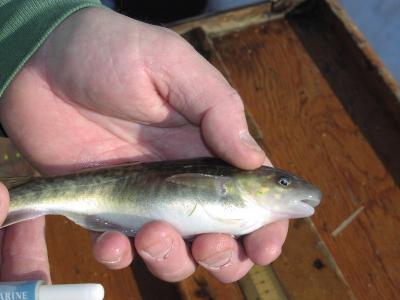General Electric released approximately 1.3 million pounds of PCBs into the Hudson River from 1947 to 1976. The Atlantic tomcod, Microgadus tomcod, is a common bottom-feeding fish in the Hudson that is not usually eaten by humans. The fish, which typically reaches a length of 10 inches, had long been known to survive exposure to PCBs, and levels of the chemical in its liver are among the highest reported in nature. However, scientists did not understand the biological mechanism that allowed the tomcod to survive chemical exposures that kill most other fishes.

Researchers discovered a mutation in tomcod living in the Hudson River that enables the fish to survive in waters heavily contaminated with PCBs. Credit: Mark Mattson of Normandeau Associates, Inc.
The team spent four years capturing tomcod from contaminated and relatively clean areas of the Hudson River during the winter months, when tomcod spawn in the river. The fish were screened for genetic variants in a gene encoding a protein known to regulate the toxic effects of PCBs, which is called the aryl hydrocarbon receptor2, or AHR2. This gene also is involved in mediating the effects of other halogenated hydrocarbon compounds, a group that includes PCBs.
Slight alterations—the deletion of only six base pairs in DNA of the AHR2 gene—appear to protect tomcod from PCBs, according to the study. Normally, when unaltered AHR2 binds to PCBs, it triggers a cascade of reactions that transmit the toxic effects of the compound. However, the study found that PCBs bind poorly to the variant AHRs, which apparently blunts the chemicals' effects.
Tomcod from cleaner waters occasionally carried mutant AHR2, suggesting that these variants existed in minor proportions prior to PCB pollution, says Dr. Wirgin. After the chemical was released, tomcod carrying the mutation had an advantage over others in the population because PCBs otherwise lead to lethal heart defects in young fish. The study's findings suggest that this advantage drove genetic changes in these fish over some fifty years.

The difference between AHR2 proteins in tomcod from Hudson River (right panel) and Shinnecock Bay (left panel) is the loss of two amino acids out of the 1,104 amino acids that normally make up the AHR protein. Illustration by Jack Cook, Woods Hole Oceanographic Institution
"We think of evolution as something that happens over thousands of generations," says Dr. Isaac Wirgin, a population geneticist, associate professor of environmental medicine at NYU School of Medicine, and the study's lead investigator. "But here it happened remarkably quickly."




Comments